Entrepreneurship: Critical Analysis of Australian Economy and Factors
VerifiedAdded on 2020/12/09
|12
|3517
|457
Report
AI Summary
This report provides a comprehensive analysis of entrepreneurship within the Australian economy. It begins by defining entrepreneurial activity and its critical role in fostering economic growth, innovation, and job creation. The report then delves into the specifics of entrepreneurship in Australia, highlighting its high rates of business ownership and the contributions of start-ups. A critical evaluation of the factors that both support and hinder entrepreneurial processes is provided, including economic, social, and psychological influences. The report examines the stages of the entrepreneurial process in Australia, from discovery and business planning to resourcing, management, and harvesting. Economic factors such as capital, labor, and market conditions are analyzed, along with social factors like family background and education. The psychological aspects, including the need for achievement and motivation, are also discussed. The report concludes by emphasizing the importance of understanding these factors for promoting entrepreneurial success and driving further economic development in Australia.

Entrepreneurship Assignment
Paraphrase This Document
Need a fresh take? Get an instant paraphrase of this document with our AI Paraphraser

TABLE OF CONTENTS
INTRODUCTION...........................................................................................................................3
Main Body.......................................................................................................................................3
1. Increasing level of entrepreneurial activity critical to the growth and development of the
Australian economy....................................................................................................................3
2. Critical Evaluation of the process and hindrance of Entrepreneurship...................................6
CONCLUSION................................................................................................................................9
REFERENCES..............................................................................................................................11
INTRODUCTION...........................................................................................................................3
Main Body.......................................................................................................................................3
1. Increasing level of entrepreneurial activity critical to the growth and development of the
Australian economy....................................................................................................................3
2. Critical Evaluation of the process and hindrance of Entrepreneurship...................................6
CONCLUSION................................................................................................................................9
REFERENCES..............................................................................................................................11
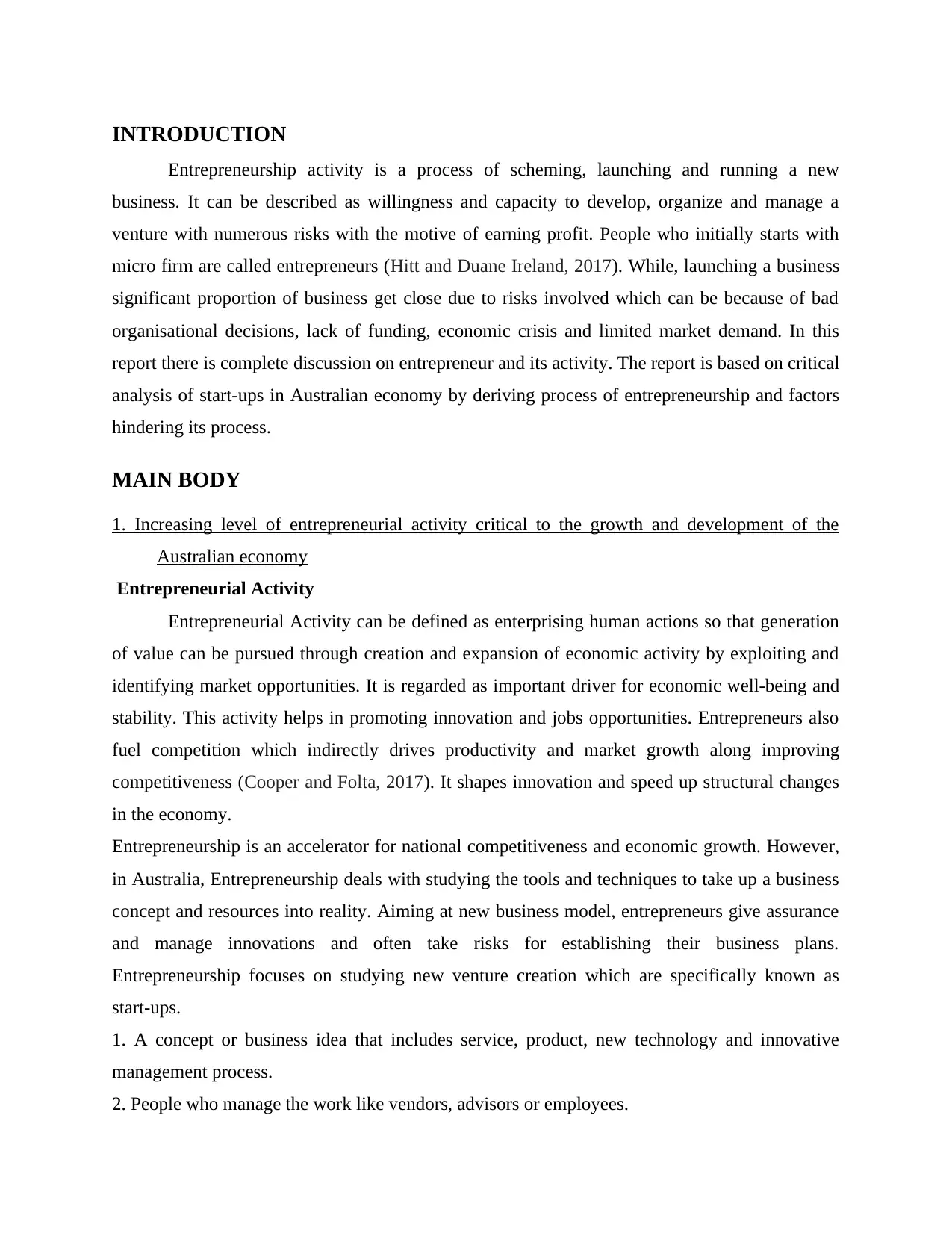
INTRODUCTION
Entrepreneurship activity is a process of scheming, launching and running a new
business. It can be described as willingness and capacity to develop, organize and manage a
venture with numerous risks with the motive of earning profit. People who initially starts with
micro firm are called entrepreneurs (Hitt and Duane Ireland, 2017). While, launching a business
significant proportion of business get close due to risks involved which can be because of bad
organisational decisions, lack of funding, economic crisis and limited market demand. In this
report there is complete discussion on entrepreneur and its activity. The report is based on critical
analysis of start-ups in Australian economy by deriving process of entrepreneurship and factors
hindering its process.
MAIN BODY
1. Increasing level of entrepreneurial activity critical to the growth and development of the
Australian economy
Entrepreneurial Activity
Entrepreneurial Activity can be defined as enterprising human actions so that generation
of value can be pursued through creation and expansion of economic activity by exploiting and
identifying market opportunities. It is regarded as important driver for economic well-being and
stability. This activity helps in promoting innovation and jobs opportunities. Entrepreneurs also
fuel competition which indirectly drives productivity and market growth along improving
competitiveness (Cooper and Folta, 2017). It shapes innovation and speed up structural changes
in the economy.
Entrepreneurship is an accelerator for national competitiveness and economic growth. However,
in Australia, Entrepreneurship deals with studying the tools and techniques to take up a business
concept and resources into reality. Aiming at new business model, entrepreneurs give assurance
and manage innovations and often take risks for establishing their business plans.
Entrepreneurship focuses on studying new venture creation which are specifically known as
start-ups.
1. A concept or business idea that includes service, product, new technology and innovative
management process.
2. People who manage the work like vendors, advisors or employees.
Entrepreneurship activity is a process of scheming, launching and running a new
business. It can be described as willingness and capacity to develop, organize and manage a
venture with numerous risks with the motive of earning profit. People who initially starts with
micro firm are called entrepreneurs (Hitt and Duane Ireland, 2017). While, launching a business
significant proportion of business get close due to risks involved which can be because of bad
organisational decisions, lack of funding, economic crisis and limited market demand. In this
report there is complete discussion on entrepreneur and its activity. The report is based on critical
analysis of start-ups in Australian economy by deriving process of entrepreneurship and factors
hindering its process.
MAIN BODY
1. Increasing level of entrepreneurial activity critical to the growth and development of the
Australian economy
Entrepreneurial Activity
Entrepreneurial Activity can be defined as enterprising human actions so that generation
of value can be pursued through creation and expansion of economic activity by exploiting and
identifying market opportunities. It is regarded as important driver for economic well-being and
stability. This activity helps in promoting innovation and jobs opportunities. Entrepreneurs also
fuel competition which indirectly drives productivity and market growth along improving
competitiveness (Cooper and Folta, 2017). It shapes innovation and speed up structural changes
in the economy.
Entrepreneurship is an accelerator for national competitiveness and economic growth. However,
in Australia, Entrepreneurship deals with studying the tools and techniques to take up a business
concept and resources into reality. Aiming at new business model, entrepreneurs give assurance
and manage innovations and often take risks for establishing their business plans.
Entrepreneurship focuses on studying new venture creation which are specifically known as
start-ups.
1. A concept or business idea that includes service, product, new technology and innovative
management process.
2. People who manage the work like vendors, advisors or employees.
⊘ This is a preview!⊘
Do you want full access?
Subscribe today to unlock all pages.

Trusted by 1+ million students worldwide

3. Procedure by which product or service or technology can be developed.
4. Sufficient money for the development of the idea that is enable to generate revenue.
Entrepreneurs are important consideration for Australian economy because they act as
coordinating agent in capitalist economic system. This coordination is further enhanced in the
form of resources for new profit opportunities. They promote capital formation by moving
different resources both tangible and intangible (Meyer, Neck and Meeks, 2017). They are
innovators that influence contemporary thinking and drive creative destruction Entrepreneurs
process, reform and revolutionize the pattern of production. There are many perspectives for
entrepreneurship which can be viewed in the following ways:
1. Pursuing opportunity
2. Recognizing Change
3. Innovating
4. Creating new value which is meaningful to customers
5. Making better use of resources
6. Taking responsibilities and risks.
Many situations in society create entrepreneurial opportunities for innovative goods and
services. These opportunities raise from variety of sources like development of new technology,
changes in understanding and knowledge, shifting demographics and changing attitude. Thus,
entrepreneurs must identify these things and innovate by presenting a business solution and
offering an exciting alternative to customers. It is the prime responsibility of them to identify
business proposition and economic value arising from that opportunities.
Entrepreneurship create social change and adds to gross national income (Rawhouser,
Cummings and Newbert, 2017). Running business are confirmed to markets and hits income
ceiling but new technologies and products generate new wealth. It can be characterised into
following ways:
1. Dynamic and economic activity: Entrepreneurship involves beginning and operation of an
enterprise with a view of generating wealth by optimum utilization of insufficient resources.
2. Innovation Related: New ideas and concepts are in regular search for Entrepreneurial activity.
It mobilizes individual to evaluate running business model so that more effective systems could
be adopted and evolved (Cooper, 2017).
4. Sufficient money for the development of the idea that is enable to generate revenue.
Entrepreneurs are important consideration for Australian economy because they act as
coordinating agent in capitalist economic system. This coordination is further enhanced in the
form of resources for new profit opportunities. They promote capital formation by moving
different resources both tangible and intangible (Meyer, Neck and Meeks, 2017). They are
innovators that influence contemporary thinking and drive creative destruction Entrepreneurs
process, reform and revolutionize the pattern of production. There are many perspectives for
entrepreneurship which can be viewed in the following ways:
1. Pursuing opportunity
2. Recognizing Change
3. Innovating
4. Creating new value which is meaningful to customers
5. Making better use of resources
6. Taking responsibilities and risks.
Many situations in society create entrepreneurial opportunities for innovative goods and
services. These opportunities raise from variety of sources like development of new technology,
changes in understanding and knowledge, shifting demographics and changing attitude. Thus,
entrepreneurs must identify these things and innovate by presenting a business solution and
offering an exciting alternative to customers. It is the prime responsibility of them to identify
business proposition and economic value arising from that opportunities.
Entrepreneurship create social change and adds to gross national income (Rawhouser,
Cummings and Newbert, 2017). Running business are confirmed to markets and hits income
ceiling but new technologies and products generate new wealth. It can be characterised into
following ways:
1. Dynamic and economic activity: Entrepreneurship involves beginning and operation of an
enterprise with a view of generating wealth by optimum utilization of insufficient resources.
2. Innovation Related: New ideas and concepts are in regular search for Entrepreneurial activity.
It mobilizes individual to evaluate running business model so that more effective systems could
be adopted and evolved (Cooper, 2017).
Paraphrase This Document
Need a fresh take? Get an instant paraphrase of this document with our AI Paraphraser
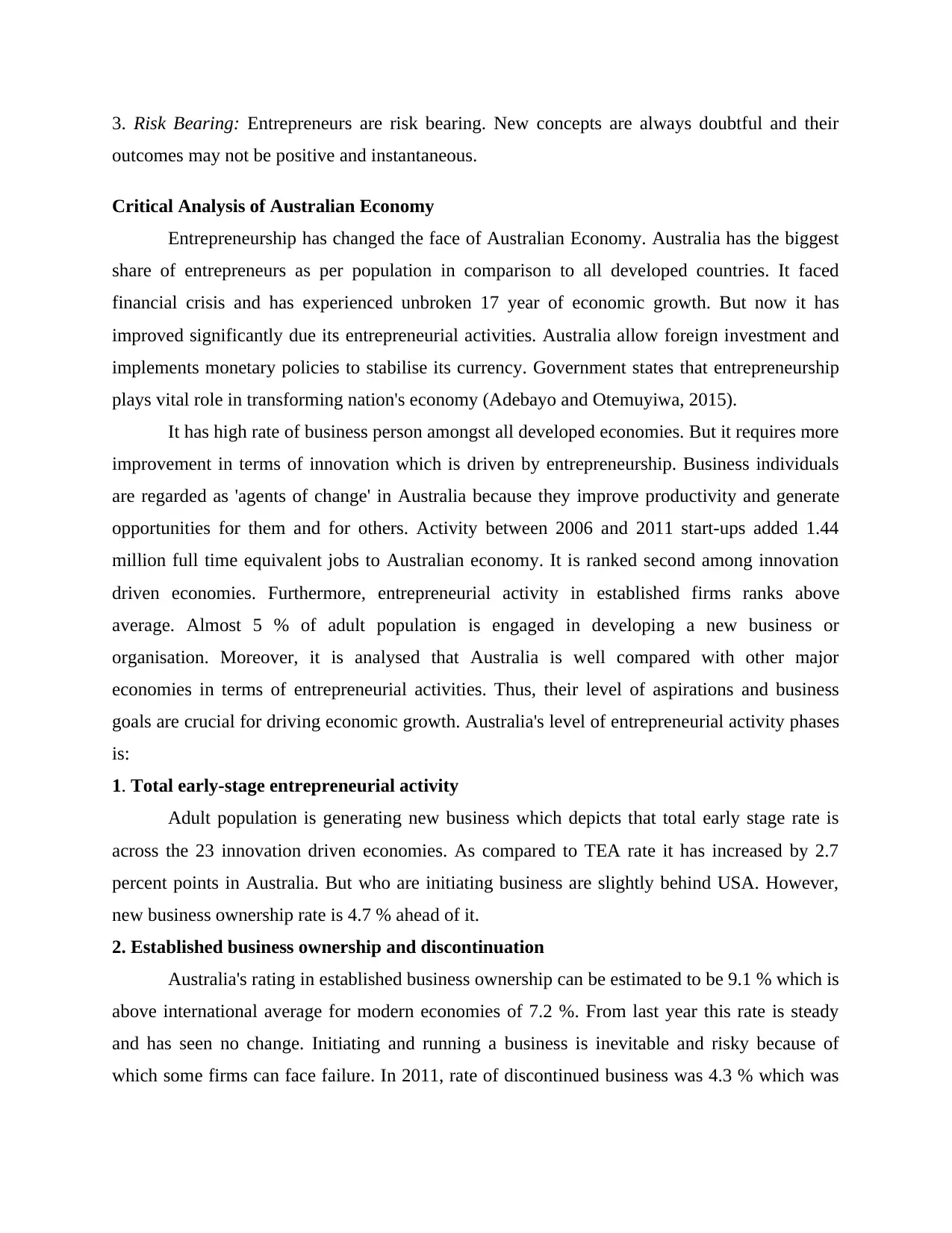
3. Risk Bearing: Entrepreneurs are risk bearing. New concepts are always doubtful and their
outcomes may not be positive and instantaneous.
Critical Analysis of Australian Economy
Entrepreneurship has changed the face of Australian Economy. Australia has the biggest
share of entrepreneurs as per population in comparison to all developed countries. It faced
financial crisis and has experienced unbroken 17 year of economic growth. But now it has
improved significantly due its entrepreneurial activities. Australia allow foreign investment and
implements monetary policies to stabilise its currency. Government states that entrepreneurship
plays vital role in transforming nation's economy (Adebayo and Otemuyiwa, 2015).
It has high rate of business person amongst all developed economies. But it requires more
improvement in terms of innovation which is driven by entrepreneurship. Business individuals
are regarded as 'agents of change' in Australia because they improve productivity and generate
opportunities for them and for others. Activity between 2006 and 2011 start-ups added 1.44
million full time equivalent jobs to Australian economy. It is ranked second among innovation
driven economies. Furthermore, entrepreneurial activity in established firms ranks above
average. Almost 5 % of adult population is engaged in developing a new business or
organisation. Moreover, it is analysed that Australia is well compared with other major
economies in terms of entrepreneurial activities. Thus, their level of aspirations and business
goals are crucial for driving economic growth. Australia's level of entrepreneurial activity phases
is:
1. Total early-stage entrepreneurial activity
Adult population is generating new business which depicts that total early stage rate is
across the 23 innovation driven economies. As compared to TEA rate it has increased by 2.7
percent points in Australia. But who are initiating business are slightly behind USA. However,
new business ownership rate is 4.7 % ahead of it.
2. Established business ownership and discontinuation
Australia's rating in established business ownership can be estimated to be 9.1 % which is
above international average for modern economies of 7.2 %. From last year this rate is steady
and has seen no change. Initiating and running a business is inevitable and risky because of
which some firms can face failure. In 2011, rate of discontinued business was 4.3 % which was
outcomes may not be positive and instantaneous.
Critical Analysis of Australian Economy
Entrepreneurship has changed the face of Australian Economy. Australia has the biggest
share of entrepreneurs as per population in comparison to all developed countries. It faced
financial crisis and has experienced unbroken 17 year of economic growth. But now it has
improved significantly due its entrepreneurial activities. Australia allow foreign investment and
implements monetary policies to stabilise its currency. Government states that entrepreneurship
plays vital role in transforming nation's economy (Adebayo and Otemuyiwa, 2015).
It has high rate of business person amongst all developed economies. But it requires more
improvement in terms of innovation which is driven by entrepreneurship. Business individuals
are regarded as 'agents of change' in Australia because they improve productivity and generate
opportunities for them and for others. Activity between 2006 and 2011 start-ups added 1.44
million full time equivalent jobs to Australian economy. It is ranked second among innovation
driven economies. Furthermore, entrepreneurial activity in established firms ranks above
average. Almost 5 % of adult population is engaged in developing a new business or
organisation. Moreover, it is analysed that Australia is well compared with other major
economies in terms of entrepreneurial activities. Thus, their level of aspirations and business
goals are crucial for driving economic growth. Australia's level of entrepreneurial activity phases
is:
1. Total early-stage entrepreneurial activity
Adult population is generating new business which depicts that total early stage rate is
across the 23 innovation driven economies. As compared to TEA rate it has increased by 2.7
percent points in Australia. But who are initiating business are slightly behind USA. However,
new business ownership rate is 4.7 % ahead of it.
2. Established business ownership and discontinuation
Australia's rating in established business ownership can be estimated to be 9.1 % which is
above international average for modern economies of 7.2 %. From last year this rate is steady
and has seen no change. Initiating and running a business is inevitable and risky because of
which some firms can face failure. In 2011, rate of discontinued business was 4.3 % which was
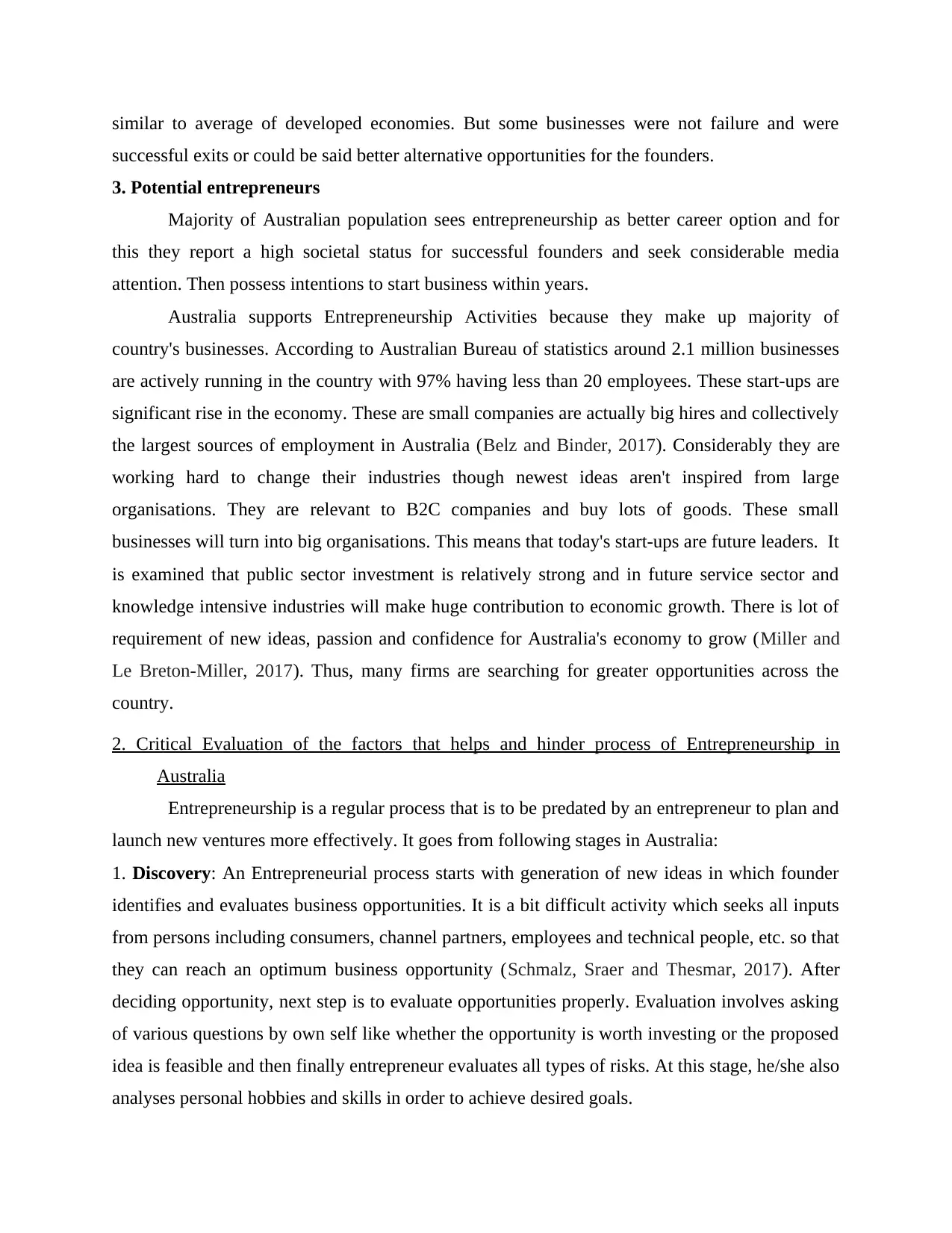
similar to average of developed economies. But some businesses were not failure and were
successful exits or could be said better alternative opportunities for the founders.
3. Potential entrepreneurs
Majority of Australian population sees entrepreneurship as better career option and for
this they report a high societal status for successful founders and seek considerable media
attention. Then possess intentions to start business within years.
Australia supports Entrepreneurship Activities because they make up majority of
country's businesses. According to Australian Bureau of statistics around 2.1 million businesses
are actively running in the country with 97% having less than 20 employees. These start-ups are
significant rise in the economy. These are small companies are actually big hires and collectively
the largest sources of employment in Australia (Belz and Binder, 2017). Considerably they are
working hard to change their industries though newest ideas aren't inspired from large
organisations. They are relevant to B2C companies and buy lots of goods. These small
businesses will turn into big organisations. This means that today's start-ups are future leaders. It
is examined that public sector investment is relatively strong and in future service sector and
knowledge intensive industries will make huge contribution to economic growth. There is lot of
requirement of new ideas, passion and confidence for Australia's economy to grow (Miller and
Le Breton‐Miller, 2017). Thus, many firms are searching for greater opportunities across the
country.
2. Critical Evaluation of the factors that helps and hinder process of Entrepreneurship in
Australia
Entrepreneurship is a regular process that is to be predated by an entrepreneur to plan and
launch new ventures more effectively. It goes from following stages in Australia:
1. Discovery: An Entrepreneurial process starts with generation of new ideas in which founder
identifies and evaluates business opportunities. It is a bit difficult activity which seeks all inputs
from persons including consumers, channel partners, employees and technical people, etc. so that
they can reach an optimum business opportunity (Schmalz, Sraer and Thesmar, 2017). After
deciding opportunity, next step is to evaluate opportunities properly. Evaluation involves asking
of various questions by own self like whether the opportunity is worth investing or the proposed
idea is feasible and then finally entrepreneur evaluates all types of risks. At this stage, he/she also
analyses personal hobbies and skills in order to achieve desired goals.
successful exits or could be said better alternative opportunities for the founders.
3. Potential entrepreneurs
Majority of Australian population sees entrepreneurship as better career option and for
this they report a high societal status for successful founders and seek considerable media
attention. Then possess intentions to start business within years.
Australia supports Entrepreneurship Activities because they make up majority of
country's businesses. According to Australian Bureau of statistics around 2.1 million businesses
are actively running in the country with 97% having less than 20 employees. These start-ups are
significant rise in the economy. These are small companies are actually big hires and collectively
the largest sources of employment in Australia (Belz and Binder, 2017). Considerably they are
working hard to change their industries though newest ideas aren't inspired from large
organisations. They are relevant to B2C companies and buy lots of goods. These small
businesses will turn into big organisations. This means that today's start-ups are future leaders. It
is examined that public sector investment is relatively strong and in future service sector and
knowledge intensive industries will make huge contribution to economic growth. There is lot of
requirement of new ideas, passion and confidence for Australia's economy to grow (Miller and
Le Breton‐Miller, 2017). Thus, many firms are searching for greater opportunities across the
country.
2. Critical Evaluation of the factors that helps and hinder process of Entrepreneurship in
Australia
Entrepreneurship is a regular process that is to be predated by an entrepreneur to plan and
launch new ventures more effectively. It goes from following stages in Australia:
1. Discovery: An Entrepreneurial process starts with generation of new ideas in which founder
identifies and evaluates business opportunities. It is a bit difficult activity which seeks all inputs
from persons including consumers, channel partners, employees and technical people, etc. so that
they can reach an optimum business opportunity (Schmalz, Sraer and Thesmar, 2017). After
deciding opportunity, next step is to evaluate opportunities properly. Evaluation involves asking
of various questions by own self like whether the opportunity is worth investing or the proposed
idea is feasible and then finally entrepreneur evaluates all types of risks. At this stage, he/she also
analyses personal hobbies and skills in order to achieve desired goals.
⊘ This is a preview!⊘
Do you want full access?
Subscribe today to unlock all pages.

Trusted by 1+ million students worldwide
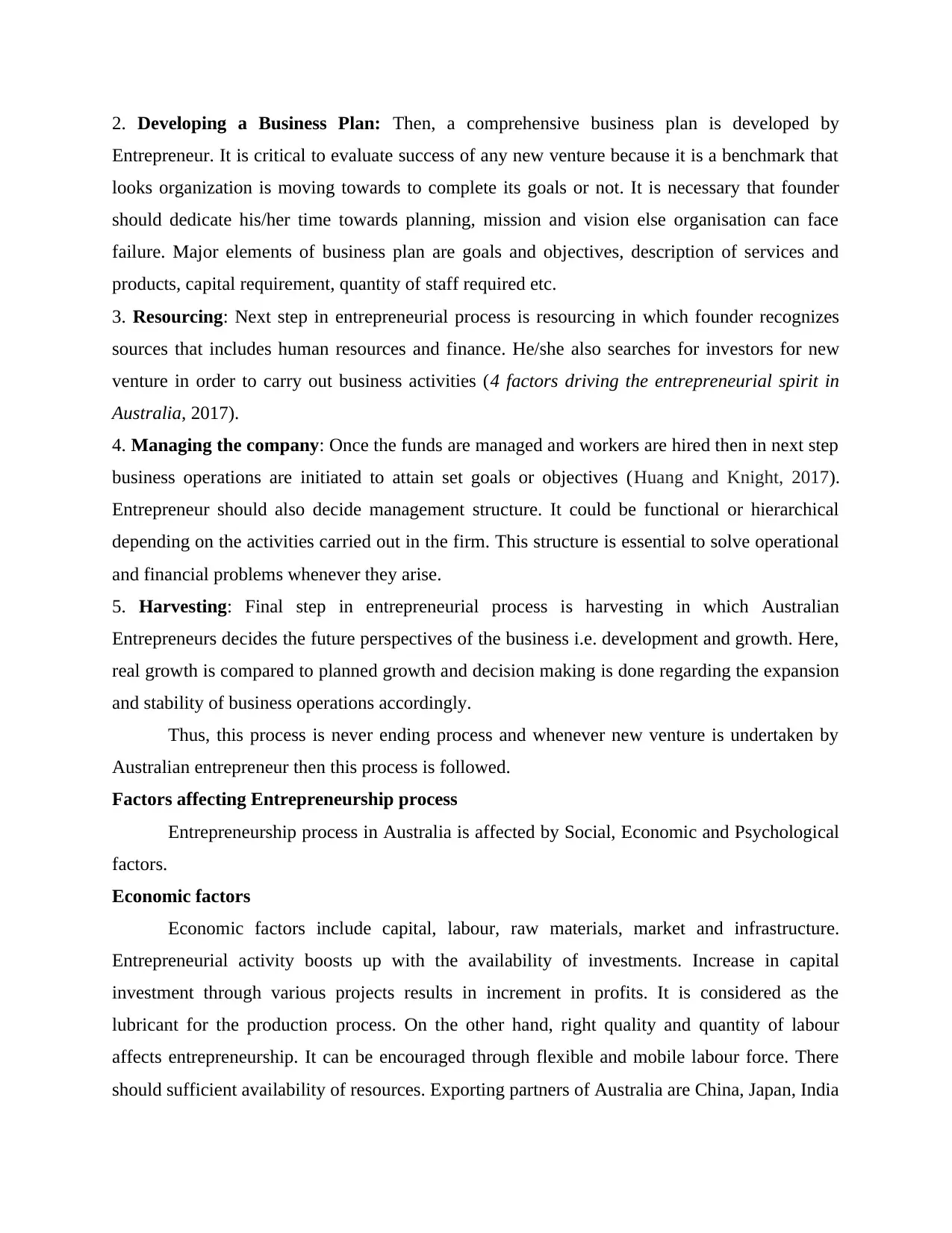
2. Developing a Business Plan: Then, a comprehensive business plan is developed by
Entrepreneur. It is critical to evaluate success of any new venture because it is a benchmark that
looks organization is moving towards to complete its goals or not. It is necessary that founder
should dedicate his/her time towards planning, mission and vision else organisation can face
failure. Major elements of business plan are goals and objectives, description of services and
products, capital requirement, quantity of staff required etc.
3. Resourcing: Next step in entrepreneurial process is resourcing in which founder recognizes
sources that includes human resources and finance. He/she also searches for investors for new
venture in order to carry out business activities (4 factors driving the entrepreneurial spirit in
Australia, 2017).
4. Managing the company: Once the funds are managed and workers are hired then in next step
business operations are initiated to attain set goals or objectives (Huang and Knight, 2017).
Entrepreneur should also decide management structure. It could be functional or hierarchical
depending on the activities carried out in the firm. This structure is essential to solve operational
and financial problems whenever they arise.
5. Harvesting: Final step in entrepreneurial process is harvesting in which Australian
Entrepreneurs decides the future perspectives of the business i.e. development and growth. Here,
real growth is compared to planned growth and decision making is done regarding the expansion
and stability of business operations accordingly.
Thus, this process is never ending process and whenever new venture is undertaken by
Australian entrepreneur then this process is followed.
Factors affecting Entrepreneurship process
Entrepreneurship process in Australia is affected by Social, Economic and Psychological
factors.
Economic factors
Economic factors include capital, labour, raw materials, market and infrastructure.
Entrepreneurial activity boosts up with the availability of investments. Increase in capital
investment through various projects results in increment in profits. It is considered as the
lubricant for the production process. On the other hand, right quality and quantity of labour
affects entrepreneurship. It can be encouraged through flexible and mobile labour force. There
should sufficient availability of resources. Exporting partners of Australia are China, Japan, India
Entrepreneur. It is critical to evaluate success of any new venture because it is a benchmark that
looks organization is moving towards to complete its goals or not. It is necessary that founder
should dedicate his/her time towards planning, mission and vision else organisation can face
failure. Major elements of business plan are goals and objectives, description of services and
products, capital requirement, quantity of staff required etc.
3. Resourcing: Next step in entrepreneurial process is resourcing in which founder recognizes
sources that includes human resources and finance. He/she also searches for investors for new
venture in order to carry out business activities (4 factors driving the entrepreneurial spirit in
Australia, 2017).
4. Managing the company: Once the funds are managed and workers are hired then in next step
business operations are initiated to attain set goals or objectives (Huang and Knight, 2017).
Entrepreneur should also decide management structure. It could be functional or hierarchical
depending on the activities carried out in the firm. This structure is essential to solve operational
and financial problems whenever they arise.
5. Harvesting: Final step in entrepreneurial process is harvesting in which Australian
Entrepreneurs decides the future perspectives of the business i.e. development and growth. Here,
real growth is compared to planned growth and decision making is done regarding the expansion
and stability of business operations accordingly.
Thus, this process is never ending process and whenever new venture is undertaken by
Australian entrepreneur then this process is followed.
Factors affecting Entrepreneurship process
Entrepreneurship process in Australia is affected by Social, Economic and Psychological
factors.
Economic factors
Economic factors include capital, labour, raw materials, market and infrastructure.
Entrepreneurial activity boosts up with the availability of investments. Increase in capital
investment through various projects results in increment in profits. It is considered as the
lubricant for the production process. On the other hand, right quality and quantity of labour
affects entrepreneurship. It can be encouraged through flexible and mobile labour force. There
should sufficient availability of resources. Exporting partners of Australia are China, Japan, India
Paraphrase This Document
Need a fresh take? Get an instant paraphrase of this document with our AI Paraphraser
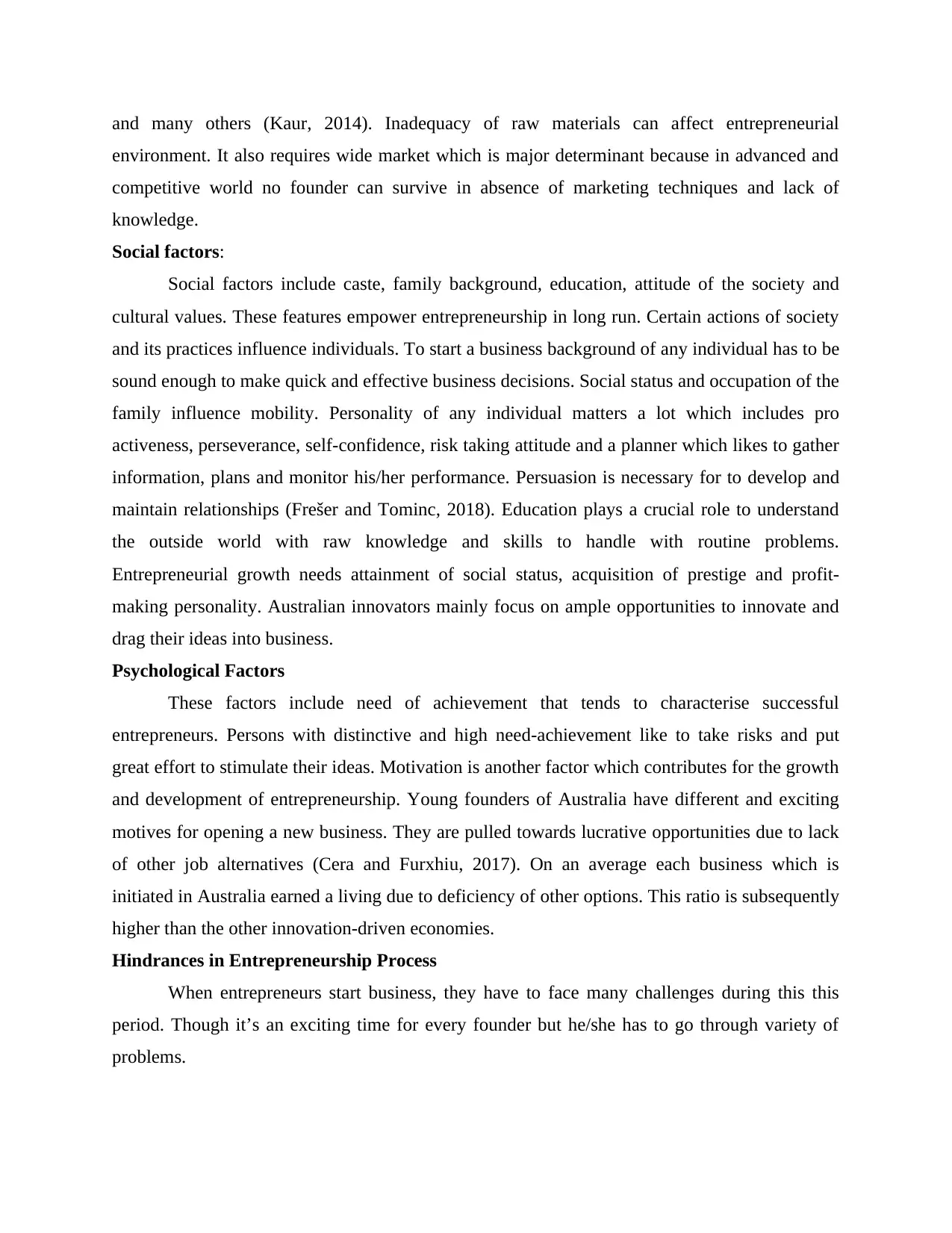
and many others (Kaur, 2014). Inadequacy of raw materials can affect entrepreneurial
environment. It also requires wide market which is major determinant because in advanced and
competitive world no founder can survive in absence of marketing techniques and lack of
knowledge.
Social factors:
Social factors include caste, family background, education, attitude of the society and
cultural values. These features empower entrepreneurship in long run. Certain actions of society
and its practices influence individuals. To start a business background of any individual has to be
sound enough to make quick and effective business decisions. Social status and occupation of the
family influence mobility. Personality of any individual matters a lot which includes pro
activeness, perseverance, self-confidence, risk taking attitude and a planner which likes to gather
information, plans and monitor his/her performance. Persuasion is necessary for to develop and
maintain relationships (Frešer and Tominc, 2018). Education plays a crucial role to understand
the outside world with raw knowledge and skills to handle with routine problems.
Entrepreneurial growth needs attainment of social status, acquisition of prestige and profit-
making personality. Australian innovators mainly focus on ample opportunities to innovate and
drag their ideas into business.
Psychological Factors
These factors include need of achievement that tends to characterise successful
entrepreneurs. Persons with distinctive and high need-achievement like to take risks and put
great effort to stimulate their ideas. Motivation is another factor which contributes for the growth
and development of entrepreneurship. Young founders of Australia have different and exciting
motives for opening a new business. They are pulled towards lucrative opportunities due to lack
of other job alternatives (Cera and Furxhiu, 2017). On an average each business which is
initiated in Australia earned a living due to deficiency of other options. This ratio is subsequently
higher than the other innovation-driven economies.
Hindrances in Entrepreneurship Process
When entrepreneurs start business, they have to face many challenges during this this
period. Though it’s an exciting time for every founder but he/she has to go through variety of
problems.
environment. It also requires wide market which is major determinant because in advanced and
competitive world no founder can survive in absence of marketing techniques and lack of
knowledge.
Social factors:
Social factors include caste, family background, education, attitude of the society and
cultural values. These features empower entrepreneurship in long run. Certain actions of society
and its practices influence individuals. To start a business background of any individual has to be
sound enough to make quick and effective business decisions. Social status and occupation of the
family influence mobility. Personality of any individual matters a lot which includes pro
activeness, perseverance, self-confidence, risk taking attitude and a planner which likes to gather
information, plans and monitor his/her performance. Persuasion is necessary for to develop and
maintain relationships (Frešer and Tominc, 2018). Education plays a crucial role to understand
the outside world with raw knowledge and skills to handle with routine problems.
Entrepreneurial growth needs attainment of social status, acquisition of prestige and profit-
making personality. Australian innovators mainly focus on ample opportunities to innovate and
drag their ideas into business.
Psychological Factors
These factors include need of achievement that tends to characterise successful
entrepreneurs. Persons with distinctive and high need-achievement like to take risks and put
great effort to stimulate their ideas. Motivation is another factor which contributes for the growth
and development of entrepreneurship. Young founders of Australia have different and exciting
motives for opening a new business. They are pulled towards lucrative opportunities due to lack
of other job alternatives (Cera and Furxhiu, 2017). On an average each business which is
initiated in Australia earned a living due to deficiency of other options. This ratio is subsequently
higher than the other innovation-driven economies.
Hindrances in Entrepreneurship Process
When entrepreneurs start business, they have to face many challenges during this this
period. Though it’s an exciting time for every founder but he/she has to go through variety of
problems.
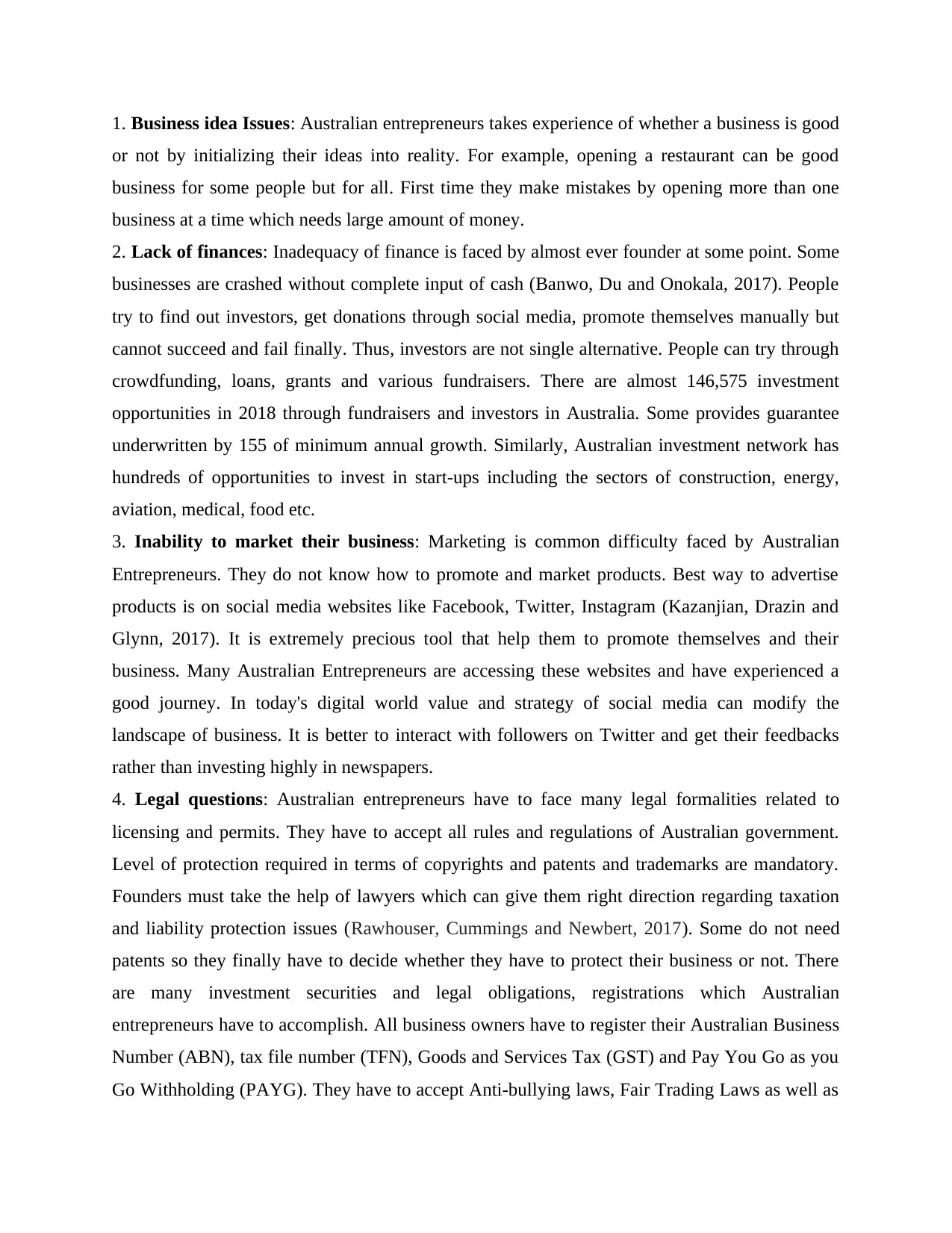
1. Business idea Issues: Australian entrepreneurs takes experience of whether a business is good
or not by initializing their ideas into reality. For example, opening a restaurant can be good
business for some people but for all. First time they make mistakes by opening more than one
business at a time which needs large amount of money.
2. Lack of finances: Inadequacy of finance is faced by almost ever founder at some point. Some
businesses are crashed without complete input of cash (Banwo, Du and Onokala, 2017). People
try to find out investors, get donations through social media, promote themselves manually but
cannot succeed and fail finally. Thus, investors are not single alternative. People can try through
crowdfunding, loans, grants and various fundraisers. There are almost 146,575 investment
opportunities in 2018 through fundraisers and investors in Australia. Some provides guarantee
underwritten by 155 of minimum annual growth. Similarly, Australian investment network has
hundreds of opportunities to invest in start-ups including the sectors of construction, energy,
aviation, medical, food etc.
3. Inability to market their business: Marketing is common difficulty faced by Australian
Entrepreneurs. They do not know how to promote and market products. Best way to advertise
products is on social media websites like Facebook, Twitter, Instagram (Kazanjian, Drazin and
Glynn, 2017). It is extremely precious tool that help them to promote themselves and their
business. Many Australian Entrepreneurs are accessing these websites and have experienced a
good journey. In today's digital world value and strategy of social media can modify the
landscape of business. It is better to interact with followers on Twitter and get their feedbacks
rather than investing highly in newspapers.
4. Legal questions: Australian entrepreneurs have to face many legal formalities related to
licensing and permits. They have to accept all rules and regulations of Australian government.
Level of protection required in terms of copyrights and patents and trademarks are mandatory.
Founders must take the help of lawyers which can give them right direction regarding taxation
and liability protection issues (Rawhouser, Cummings and Newbert, 2017). Some do not need
patents so they finally have to decide whether they have to protect their business or not. There
are many investment securities and legal obligations, registrations which Australian
entrepreneurs have to accomplish. All business owners have to register their Australian Business
Number (ABN), tax file number (TFN), Goods and Services Tax (GST) and Pay You Go as you
Go Withholding (PAYG). They have to accept Anti-bullying laws, Fair Trading Laws as well as
or not by initializing their ideas into reality. For example, opening a restaurant can be good
business for some people but for all. First time they make mistakes by opening more than one
business at a time which needs large amount of money.
2. Lack of finances: Inadequacy of finance is faced by almost ever founder at some point. Some
businesses are crashed without complete input of cash (Banwo, Du and Onokala, 2017). People
try to find out investors, get donations through social media, promote themselves manually but
cannot succeed and fail finally. Thus, investors are not single alternative. People can try through
crowdfunding, loans, grants and various fundraisers. There are almost 146,575 investment
opportunities in 2018 through fundraisers and investors in Australia. Some provides guarantee
underwritten by 155 of minimum annual growth. Similarly, Australian investment network has
hundreds of opportunities to invest in start-ups including the sectors of construction, energy,
aviation, medical, food etc.
3. Inability to market their business: Marketing is common difficulty faced by Australian
Entrepreneurs. They do not know how to promote and market products. Best way to advertise
products is on social media websites like Facebook, Twitter, Instagram (Kazanjian, Drazin and
Glynn, 2017). It is extremely precious tool that help them to promote themselves and their
business. Many Australian Entrepreneurs are accessing these websites and have experienced a
good journey. In today's digital world value and strategy of social media can modify the
landscape of business. It is better to interact with followers on Twitter and get their feedbacks
rather than investing highly in newspapers.
4. Legal questions: Australian entrepreneurs have to face many legal formalities related to
licensing and permits. They have to accept all rules and regulations of Australian government.
Level of protection required in terms of copyrights and patents and trademarks are mandatory.
Founders must take the help of lawyers which can give them right direction regarding taxation
and liability protection issues (Rawhouser, Cummings and Newbert, 2017). Some do not need
patents so they finally have to decide whether they have to protect their business or not. There
are many investment securities and legal obligations, registrations which Australian
entrepreneurs have to accomplish. All business owners have to register their Australian Business
Number (ABN), tax file number (TFN), Goods and Services Tax (GST) and Pay You Go as you
Go Withholding (PAYG). They have to accept Anti-bullying laws, Fair Trading Laws as well as
⊘ This is a preview!⊘
Do you want full access?
Subscribe today to unlock all pages.

Trusted by 1+ million students worldwide
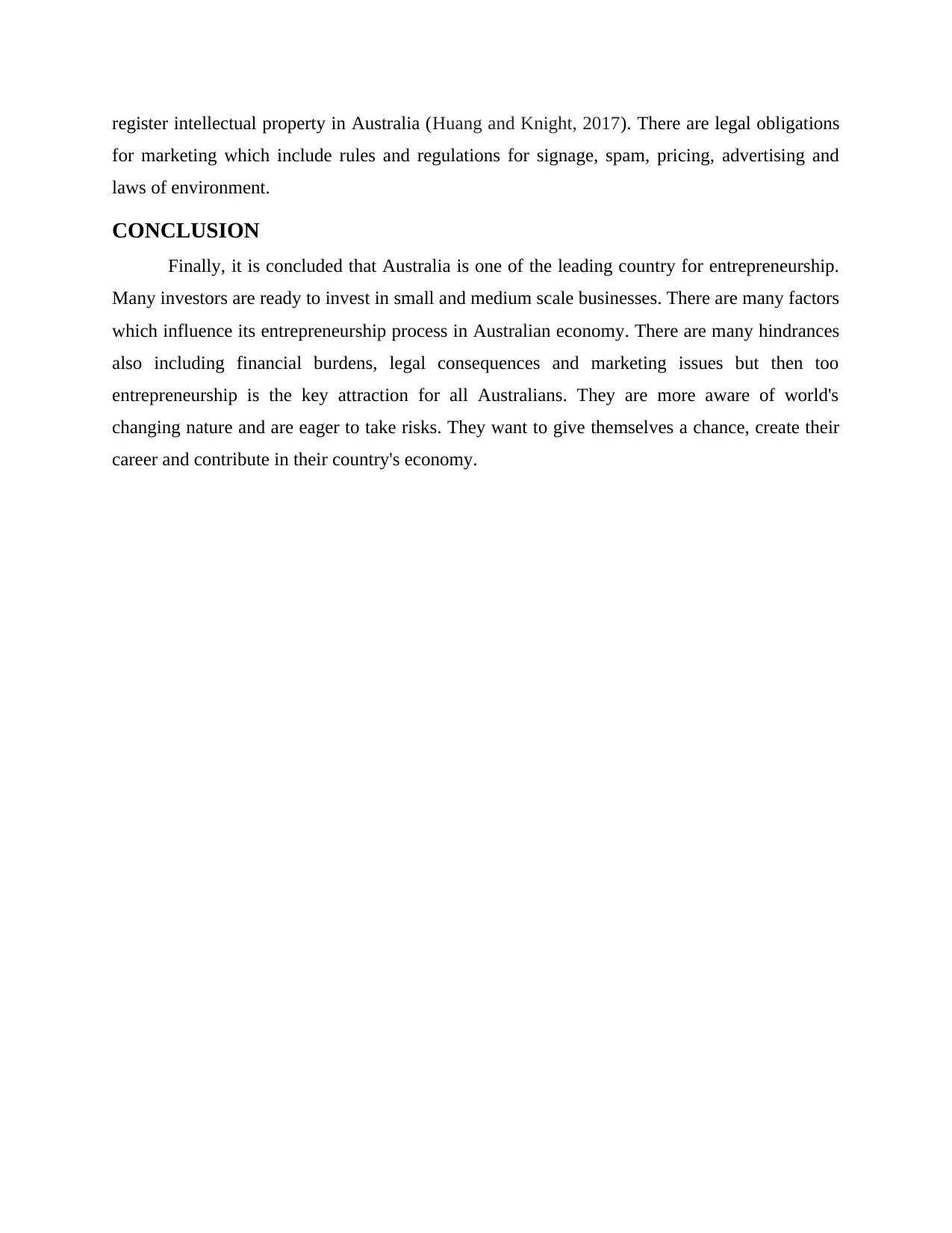
register intellectual property in Australia (Huang and Knight, 2017). There are legal obligations
for marketing which include rules and regulations for signage, spam, pricing, advertising and
laws of environment.
CONCLUSION
Finally, it is concluded that Australia is one of the leading country for entrepreneurship.
Many investors are ready to invest in small and medium scale businesses. There are many factors
which influence its entrepreneurship process in Australian economy. There are many hindrances
also including financial burdens, legal consequences and marketing issues but then too
entrepreneurship is the key attraction for all Australians. They are more aware of world's
changing nature and are eager to take risks. They want to give themselves a chance, create their
career and contribute in their country's economy.
for marketing which include rules and regulations for signage, spam, pricing, advertising and
laws of environment.
CONCLUSION
Finally, it is concluded that Australia is one of the leading country for entrepreneurship.
Many investors are ready to invest in small and medium scale businesses. There are many factors
which influence its entrepreneurship process in Australian economy. There are many hindrances
also including financial burdens, legal consequences and marketing issues but then too
entrepreneurship is the key attraction for all Australians. They are more aware of world's
changing nature and are eager to take risks. They want to give themselves a chance, create their
career and contribute in their country's economy.
Paraphrase This Document
Need a fresh take? Get an instant paraphrase of this document with our AI Paraphraser
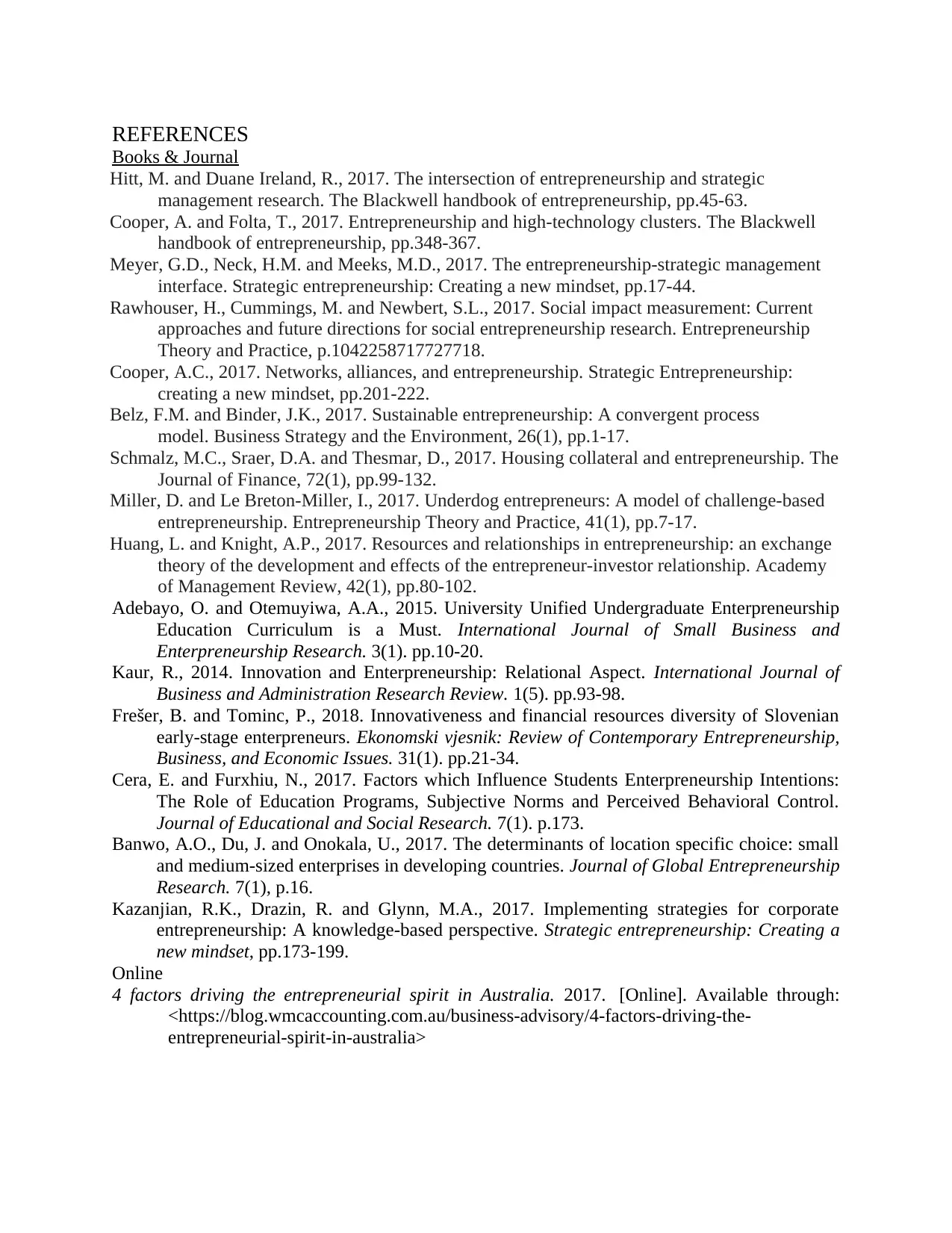
REFERENCES
Books & Journal
Hitt, M. and Duane Ireland, R., 2017. The intersection of entrepreneurship and strategic
management research. The Blackwell handbook of entrepreneurship, pp.45-63.
Cooper, A. and Folta, T., 2017. Entrepreneurship and high‐technology clusters. The Blackwell
handbook of entrepreneurship, pp.348-367.
Meyer, G.D., Neck, H.M. and Meeks, M.D., 2017. The entrepreneurship‐strategic management
interface. Strategic entrepreneurship: Creating a new mindset, pp.17-44.
Rawhouser, H., Cummings, M. and Newbert, S.L., 2017. Social impact measurement: Current
approaches and future directions for social entrepreneurship research. Entrepreneurship
Theory and Practice, p.1042258717727718.
Cooper, A.C., 2017. Networks, alliances, and entrepreneurship. Strategic Entrepreneurship:
creating a new mindset, pp.201-222.
Belz, F.M. and Binder, J.K., 2017. Sustainable entrepreneurship: A convergent process
model. Business Strategy and the Environment, 26(1), pp.1-17.
Schmalz, M.C., Sraer, D.A. and Thesmar, D., 2017. Housing collateral and entrepreneurship. The
Journal of Finance, 72(1), pp.99-132.
Miller, D. and Le Breton‐Miller, I., 2017. Underdog entrepreneurs: A model of challenge‐based
entrepreneurship. Entrepreneurship Theory and Practice, 41(1), pp.7-17.
Huang, L. and Knight, A.P., 2017. Resources and relationships in entrepreneurship: an exchange
theory of the development and effects of the entrepreneur-investor relationship. Academy
of Management Review, 42(1), pp.80-102.
Adebayo, O. and Otemuyiwa, A.A., 2015. University Unified Undergraduate Enterpreneurship
Education Curriculum is a Must. International Journal of Small Business and
Enterpreneurship Research. 3(1). pp.10-20.
Kaur, R., 2014. Innovation and Enterpreneurship: Relational Aspect. International Journal of
Business and Administration Research Review. 1(5). pp.93-98.
Frešer, B. and Tominc, P., 2018. Innovativeness and financial resources diversity of Slovenian
early-stage enterpreneurs. Ekonomski vjesnik: Review of Contemporary Entrepreneurship,
Business, and Economic Issues. 31(1). pp.21-34.
Cera, E. and Furxhiu, N., 2017. Factors which Influence Students Enterpreneurship Intentions:
The Role of Education Programs, Subjective Norms and Perceived Behavioral Control.
Journal of Educational and Social Research. 7(1). p.173.
Banwo, A.O., Du, J. and Onokala, U., 2017. The determinants of location specific choice: small
and medium-sized enterprises in developing countries. Journal of Global Entrepreneurship
Research. 7(1), p.16.
Kazanjian, R.K., Drazin, R. and Glynn, M.A., 2017. Implementing strategies for corporate
entrepreneurship: A knowledge‐based perspective. Strategic entrepreneurship: Creating a
new mindset, pp.173-199.
Online
4 factors driving the entrepreneurial spirit in Australia. 2017. [Online]. Available through:
<https://blog.wmcaccounting.com.au/business-advisory/4-factors-driving-the-
entrepreneurial-spirit-in-australia>
Books & Journal
Hitt, M. and Duane Ireland, R., 2017. The intersection of entrepreneurship and strategic
management research. The Blackwell handbook of entrepreneurship, pp.45-63.
Cooper, A. and Folta, T., 2017. Entrepreneurship and high‐technology clusters. The Blackwell
handbook of entrepreneurship, pp.348-367.
Meyer, G.D., Neck, H.M. and Meeks, M.D., 2017. The entrepreneurship‐strategic management
interface. Strategic entrepreneurship: Creating a new mindset, pp.17-44.
Rawhouser, H., Cummings, M. and Newbert, S.L., 2017. Social impact measurement: Current
approaches and future directions for social entrepreneurship research. Entrepreneurship
Theory and Practice, p.1042258717727718.
Cooper, A.C., 2017. Networks, alliances, and entrepreneurship. Strategic Entrepreneurship:
creating a new mindset, pp.201-222.
Belz, F.M. and Binder, J.K., 2017. Sustainable entrepreneurship: A convergent process
model. Business Strategy and the Environment, 26(1), pp.1-17.
Schmalz, M.C., Sraer, D.A. and Thesmar, D., 2017. Housing collateral and entrepreneurship. The
Journal of Finance, 72(1), pp.99-132.
Miller, D. and Le Breton‐Miller, I., 2017. Underdog entrepreneurs: A model of challenge‐based
entrepreneurship. Entrepreneurship Theory and Practice, 41(1), pp.7-17.
Huang, L. and Knight, A.P., 2017. Resources and relationships in entrepreneurship: an exchange
theory of the development and effects of the entrepreneur-investor relationship. Academy
of Management Review, 42(1), pp.80-102.
Adebayo, O. and Otemuyiwa, A.A., 2015. University Unified Undergraduate Enterpreneurship
Education Curriculum is a Must. International Journal of Small Business and
Enterpreneurship Research. 3(1). pp.10-20.
Kaur, R., 2014. Innovation and Enterpreneurship: Relational Aspect. International Journal of
Business and Administration Research Review. 1(5). pp.93-98.
Frešer, B. and Tominc, P., 2018. Innovativeness and financial resources diversity of Slovenian
early-stage enterpreneurs. Ekonomski vjesnik: Review of Contemporary Entrepreneurship,
Business, and Economic Issues. 31(1). pp.21-34.
Cera, E. and Furxhiu, N., 2017. Factors which Influence Students Enterpreneurship Intentions:
The Role of Education Programs, Subjective Norms and Perceived Behavioral Control.
Journal of Educational and Social Research. 7(1). p.173.
Banwo, A.O., Du, J. and Onokala, U., 2017. The determinants of location specific choice: small
and medium-sized enterprises in developing countries. Journal of Global Entrepreneurship
Research. 7(1), p.16.
Kazanjian, R.K., Drazin, R. and Glynn, M.A., 2017. Implementing strategies for corporate
entrepreneurship: A knowledge‐based perspective. Strategic entrepreneurship: Creating a
new mindset, pp.173-199.
Online
4 factors driving the entrepreneurial spirit in Australia. 2017. [Online]. Available through:
<https://blog.wmcaccounting.com.au/business-advisory/4-factors-driving-the-
entrepreneurial-spirit-in-australia>

⊘ This is a preview!⊘
Do you want full access?
Subscribe today to unlock all pages.

Trusted by 1+ million students worldwide
1 out of 12
Related Documents
Your All-in-One AI-Powered Toolkit for Academic Success.
+13062052269
info@desklib.com
Available 24*7 on WhatsApp / Email
![[object Object]](/_next/static/media/star-bottom.7253800d.svg)
Unlock your academic potential
Copyright © 2020–2025 A2Z Services. All Rights Reserved. Developed and managed by ZUCOL.



